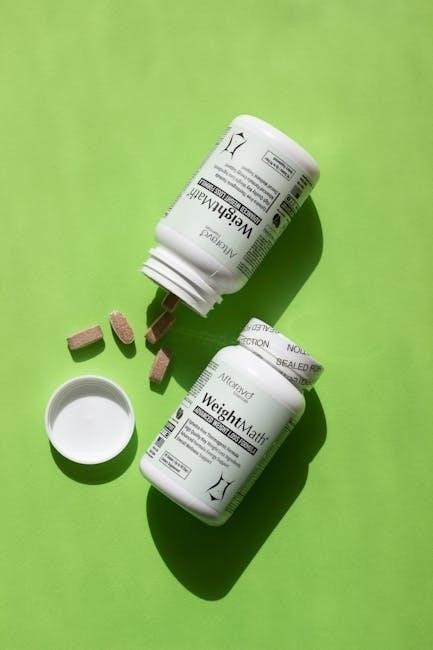A stomach ulcer diet focuses on managing symptoms and promoting healing through dietary changes. It helps reduce pain, prevent complications, and avoid triggers that irritate the stomach lining.
1.1 Understanding Stomach Ulcers
Stomach ulcers, also known as peptic or gastric ulcers, are sores that develop in the lining of the stomach or duodenum. They often result from Helicobacter pylori infection or NSAID use, causing pain, bleeding, and complications if untreated. Managing symptoms and promoting healing requires a tailored diet to reduce acid production and avoid irritants.
1.2 Importance of Diet in Managing Stomach Ulcers
Diet plays a crucial role in managing stomach ulcers by reducing symptoms, preventing complications, and promoting healing. A well-balanced diet avoids irritants, reduces acid production, and supports the stomach lining. It helps restore the gastrointestinal lining, alleviating pain and discomfort, while minimizing the need for long-term medication.
Causes of Stomach Ulcers
Stomach ulcers are primarily caused by Helicobacter pylori infection and the use of NSAIDs, which damage the stomach lining and disrupt its protective barrier.
2.1 Role of Helicobacter Pylori Infection
Helicobacter pylori infection is a primary cause of stomach ulcers, damaging the stomach lining and causing inflammation. This bacteria disrupts the protective mucus barrier, allowing acid to irritate the tissue and form ulcers. It is a common cause of peptic ulcers and is linked to chronic gastritis and other gastrointestinal disorders.
2.2 Impact of NSAIDs on Stomach Lining
Nonsteroidal anti-inflammatory drugs (NSAIDs) can erode the stomach lining, reducing its protective mucus barrier and leading to ulcers. Long-term use of NSAIDs inhibits the production of prostaglandins, which help maintain stomach lining integrity, increasing the risk of gastric damage and delaying healing.

General Dietary Principles for Stomach Ulcers
A stomach ulcer diet emphasizes balanced nutrition to manage symptoms and promote healing. Focus on whole grains, vegetables, fruits, lean proteins, and healthy fats while avoiding stomach irritants.
3.1 Balancing Nutrients for Healing
A balanced diet rich in whole grains, vegetables, and fruits provides essential nutrients for healing. Fiber reduces acid production, while lean proteins and healthy fats support tissue repair. Avoiding irritants like spicy or fatty foods helps maintain a soothing environment for the stomach lining to heal effectively and prevent further complications.
3.2 Avoiding Foods That Trigger Symptoms
Identifying and avoiding foods that trigger symptoms is crucial for managing stomach ulcers; Spicy, acidic, and high-fat foods can irritate the stomach lining, worsening discomfort. Eliminating these from your diet helps reduce inflammation and promotes a healing environment. Personal triggers vary, so tracking symptoms and adjusting your diet accordingly is essential for effective management.

Foods to Include in a Stomach Ulcer Diet
Incorporate whole, nutrient-rich foods like lean proteins, healthy fats, and low-acid fruits and vegetables to support healing and reduce inflammation without irritating the stomach lining.
4.1 High-Fiber Foods for Acid Reduction
High-fiber foods, such as whole grains, fruits, and vegetables, help reduce stomach acid by absorbing excess acid and soothing irritation. They form a protective barrier against acid, promoting healing and preventing ulcer recurrence. Include soluble fiber-rich options like oats, barley, apples, and carrots to support digestive health and alleviate symptoms effectively.
4.2 Lean Proteins and Their Benefits
Lean proteins like poultry, fish, and plant-based options support healing without triggering acid production. They provide essential nutrients for tissue repair and maintain a balanced diet. Avoid high-fat meats and opt for low-fat cooking methods to reduce stomach irritation and promote a soothing environment for ulcer healing and recovery.
4.3 Healthy Fats and Oils
Healthy fats like olive oil, avocado, and nuts reduce inflammation and protect the stomach lining. They promote digestion without triggering acid production, aiding in ulcer healing. Incorporate sources like fatty fish for omega-3 benefits, but avoid fried foods and excessive fat intake to prevent discomfort and support overall digestive health.
4.4 Low-Acid Fruits and Vegetables
Low-acid fruits and vegetables, such as bananas, melons, and leafy greens, are ideal for a stomach ulcer diet. They help neutralize stomach acid and reduce irritation. Non-acidic options like carrots, celery, and green beans are gentle on the stomach lining, promoting healing and preventing discomfort. Incorporate these into meals to support digestive health.
Foods to Avoid in a Stomach Ulcer Diet
Foods to avoid include spicy, acidic, and high-fat items, as well as processed foods, caffeine, and alcohol, which can irritate the stomach lining and worsen symptoms.
5.1 Spicy and Acidic Foods
Spicy and acidic foods can irritate the stomach lining, worsening ulcer symptoms. Examples include citrus fruits, tomatoes, vinegar, and hot peppers. These foods increase stomach acid production, causing discomfort and slowing the healing process. Moderation is key, and some individuals may need to avoid these foods entirely to manage their condition effectively.
5.2 High-Fat and Fried Foods
High-fat and fried foods can slow healing and worsen symptoms by delaying stomach emptying and increasing acid production. Foods like fried meats, processed snacks, and heavy sauces should be avoided. These items can irritate the stomach lining and exacerbate discomfort. Opting for leaner, less greasy alternatives supports healing and reduces irritation.
5.3 Processed Foods and Sugars
Processed foods and sugars can trigger stomach acid production, worsening ulcer symptoms. They often contain harmful additives that delay healing and cause inflammation. Opt for whole, nutrient-rich foods like fruits, vegetables, and lean proteins instead. Avoid foods with added sugars and opt for natural sources like fruits. This approach supports healing and reduces discomfort effectively.
5.4 Caffeine and Alcohol
Caffeine and alcohol can increase stomach acid production, worsening ulcer symptoms. Both can irritate the stomach lining and delay healing. Limit or avoid these substances to reduce discomfort. Opt for herbal teas or water instead of coffee, and choose non-alcoholic beverages to support healing and manage symptoms effectively.

Meal Frequency and Portion Control
Eating smaller, frequent meals helps reduce stomach acid spikes and eases digestion. Avoiding heavy meals prevents overloading the stomach, which can worsen symptoms and delay healing.
6.1 Benefits of Smaller, More Frequent Meals
Smaller, more frequent meals reduce stomach acid spikes and ease digestion. This approach minimizes irritation and supports healing by avoiding overloading the stomach. It helps maintain a stable environment for the stomach lining to repair and reduces the risk of discomfort or pain associated with larger, less frequent meals.
6.2 Avoiding Overeating and Heavy Meals
Avoiding overeating and heavy meals reduces strain on the stomach, preventing excessive acid production. Large meals can irritate the stomach lining, worsening ulcer symptoms. Eating balanced, moderate portions supports healing and maintains a stable digestive environment, helping to alleviate discomfort and prevent acid spikes that can impede recovery.
Role of Fiber in Stomach Ulcer Healing
Fiber aids in healing by lowering stomach acid, reducing inflammation, and preventing future ulcers. A diet rich in soluble fiber supports the stomach lining and eases symptoms.
7.1 Soluble Fiber and Its Benefits
Soluble fiber forms a protective gel-like barrier over the stomach lining, shielding it from acid and reducing inflammation. It helps lower acid production, alleviates symptoms, and supports healing. Foods rich in soluble fiber, such as oats and barley, are ideal for soothing ulcers and promoting a healthy digestive environment.
7.2 Foods Rich in Viscous Fiber
Foods rich in viscous fiber, such as whole grains, legumes, and certain vegetables, form a thick, gel-like layer in the stomach. This layer protects the lining from acid, reducing irritation and inflammation. Viscous fiber also slows gastric emptying, allowing the stomach to heal and lowering the risk of further damage.

Avoiding Stomach Irritants
Avoiding stomach irritants is crucial for healing. Identifying and managing trigger foods helps reduce inflammation and supports the stomach lining’s recovery process effectively.
8.1 Identifying Personal Trigger Foods
Identifying personal trigger foods is essential for managing symptoms. Keep a food diary to track which foods cause discomfort or pain. Common irritants include spicy, fatty, or acidic foods. By recognizing and avoiding these triggers, individuals can reduce inflammation and promote healing of the stomach lining, ensuring a more comfortable recovery process.
8.2 Managing Food Sensitivities
Managing food sensitivities involves gradually reintroducing foods to identify tolerances. Start with bland, non-irritating options and monitor symptoms. Avoid foods that consistently cause discomfort. Consulting a dietitian can help tailor a plan that minimizes sensitivities while ensuring proper nutrition. This approach reduces inflammation and supports the healing process effectively.
Protein Sources in a Stomach Ulcer Diet
Incorporate lean proteins like poultry, fish, and plant-based options to maintain a balanced diet that avoids irritating the stomach lining and supports healing.
9.1 Lean Meats and Poultry
Lean meats and poultry, such as chicken and turkey, are excellent protein sources for a stomach ulcer diet. They are low in fat and easy to digest, reducing irritation. Opt for baked or grilled options without skin to minimize fat intake and promote healing. These proteins provide essential nutrients without triggering acid production.
9.2 Fish and Seafood Options
Fatty fish like salmon and cod, as well as tilapia, are excellent choices for a stomach ulcer diet. They are rich in omega-3 fatty acids, which reduce inflammation and promote healing. Opt for baked, steamed, or grilled options without heavy sauces. Shellfish like shrimp and lobster can also be included, but avoid fried or high-sodium versions.
9.3 Plant-Based Protein Sources
Plant-based proteins like beans, lentils, tofu, and quinoa are excellent for a stomach ulcer diet. They are gentle on the stomach, rich in fiber, and help reduce acid. Opt for baked, steamed, or low-sodium broth preparations. These options provide essential nutrients while avoiding irritation, supporting healing and overall digestive health effectively.
Healthy Fats and Oils
Healthy fats like olive oil, avocado, and flaxseed support healing by reducing inflammation and protecting the stomach lining without causing irritation or acid production.
10.1 Benefits of Olive Oil
Olive oil is rich in antioxidants and has anti-inflammatory properties, which can help soothe the stomach lining and reduce inflammation. It may also protect against acid damage and promote healing in the digestive tract, making it a beneficial addition to a stomach ulcer diet.
10.2 Other Healthy Fats to Include
Other healthy fats like avocado, nuts, and seeds (e.g., flaxseeds, chia seeds) are beneficial. They provide omega-3 fatty acids and fiber, which can reduce inflammation and support stomach healing. These fats are gentle on the digestive system and help balance acid production, making them ideal for a stomach ulcer diet.
Lifestyle Considerations
Lifestyle changes, such as managing stress, avoiding smoking, and limiting alcohol, play a crucial role in managing stomach ulcers. These adjustments support healing and reduce symptom recurrence effectively.
11.1 Managing Stress
Stress can exacerbate stomach ulcer symptoms by increasing acid production. Techniques like deep breathing, yoga, and meditation help reduce stress levels, promoting healing and preventing symptom flare-ups effectively.
11.2 Avoiding Smoking and Alcohol
Smoking and alcohol can worsen stomach ulcer symptoms by delaying healing and increasing acid production. Smoking reduces blood flow to the stomach lining, while alcohol irritates it. Avoiding these habits supports faster recovery and reduces discomfort, aiding in the management of peptic ulcers effectively.
Sample 7-Day Meal Plan for Stomach Ulcers
A sample 7-day meal plan for stomach ulcers includes balanced, low-acid foods like lean proteins, high-fiber vegetables, and whole grains, helping to soothe and heal the stomach lining effectively.
12.1 Breakfast Ideas
- Oatmeal with sliced bananas and a drizzle of honey for gentle digestion.
- Scrambled eggs with spinach and whole-grain toast for a lean protein start.
- Unflavored, unsweetened yogurt with berries for probiotic benefits.
- Smoothies made with low-acid fruits like pears or apples and spinach.
- Whole-grain cereal with almond milk and a sprinkle of chia seeds.
12.2 Lunch and Dinner Options
- Grilled chicken or turkey with steamed vegetables like carrots and green beans.
- Fish such as cod or salmon, baked with herbs and served with quinoa.
- Lentil or vegetable soup with whole-grain bread for a soothing meal.
- Stir-fried tofu with zucchini, bell peppers, and brown rice.
- AVOCADO
- Bananas or applesauce for soothing, easy-to-digest options.
- A small handful of almonds or pumpkin seeds for healthy fats.
- Plain toast or rice cakes with a drizzle of honey.
- Low-fat yogurt or kefir to support gut health.
- Steamed or cooked vegetables like carrots or zucchini.
12.3 Snack Recommendations
These snacks are gentle on the stomach and promote healing.
A consistent stomach ulcer diet is crucial for healing and preventing recurrences. Consult a dietitian or doctor for personalized advice and further guidance on managing symptoms effectively.
13.1 Importance of Consistency in Diet
Consistency in following a stomach ulcer diet is key to healing and preventing recurrences. Regularly adhering to dietary guidelines helps maintain a healthy stomach lining, reduces acid production, and avoids irritants. Over time, this consistency supports long-term recovery and minimizes the risk of symptoms returning, promoting overall digestive well-being and reducing complications.
13.2 When to Consult a Dietitian
Consult a dietitian if symptoms persist despite dietary changes or if managing food restrictions becomes challenging. They can help tailor a meal plan to meet nutritional needs, ensure adequate healing, and address specific concerns, providing personalized guidance for managing stomach ulcers effectively.
